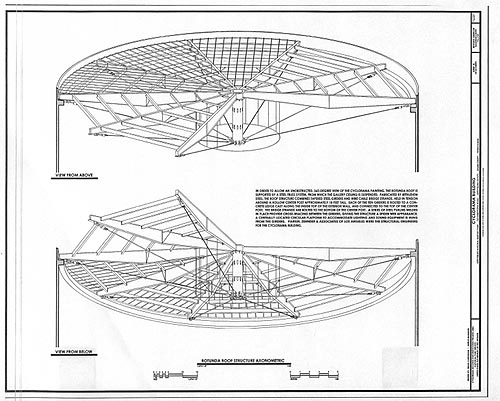|
More
photographs, drawings, and sketches here
High
Resolution Downloads for Publication
ask
CM French for permission before printing
History:
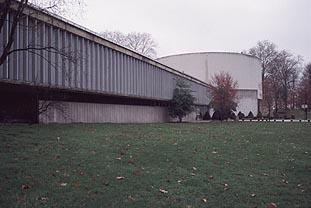 In
1996, the National Park Service officials announced their intention
to demolish Neutra and Alexander's 1961 modernist Cyclorama Building
at Gettysburg, Pennsylvania, a premiere first generation "visitor
center" and a stunning example of a master architect's late-life
aspirations. Despite its recent listing on the National Register of
Historic Places for its ""its exceptional historic and architectural
significance," the long-neglected building stands in the way of
National Park Service plans to "restore" the battlefield landscape
and move visitor facilities into a new interpretive center designed
in a "more appropriate" architectural style. In
1996, the National Park Service officials announced their intention
to demolish Neutra and Alexander's 1961 modernist Cyclorama Building
at Gettysburg, Pennsylvania, a premiere first generation "visitor
center" and a stunning example of a master architect's late-life
aspirations. Despite its recent listing on the National Register of
Historic Places for its ""its exceptional historic and architectural
significance," the long-neglected building stands in the way of
National Park Service plans to "restore" the battlefield landscape
and move visitor facilities into a new interpretive center designed
in a "more appropriate" architectural style.
The Gettysburg project posed considerable challenges for architect Richard
Neutra. Commissioned as a flagship building for the National Park Service's
"Mission 66" program -- a nationwide, billion-dollar program
to modernize the U.S. parks -- the new visitor center had to house a
massive 1883 panoramic painting depicting the battle of Gettysburg and
occupy one of the most famous sites in American history. Neutra created
a drum-shaped concrete rotunda to house the 40-foot high circular canvas;
a glass, concrete, and stone wing accommodates ranger's offices and
information services. Park officials insisted that the building be constructed
on a prominent site overlooking the field where Pickett made his famous
charge during the pivotal 1883 battle - the same spot 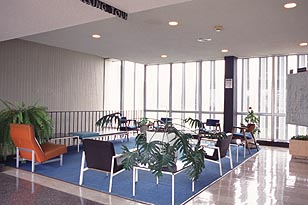 depicted
in the painting's brilliant scenography and a location deemed most convenient
for the multitudes expected to visit the building during the 100th anniversary
of the Civil War. depicted
in the painting's brilliant scenography and a location deemed most convenient
for the multitudes expected to visit the building during the 100th anniversary
of the Civil War.
At its opening
The New York Times predicted that this "handsome new $1,000,000
Park Visitor Center" would "become one of the showplaces of
the National Park System." The Washington Post praised the "quietly
monumental but entirely unsentimental" Neutra design, citing the
Cyclorama Center as one of a set of "exceptionally distinguished
and fearlessly modern" buildings in the national parks, each deserving
of an architectural excellence award. In 1970, the American Institute
of Architects agreed, honoring Mission 66 and the Park Service for the
innovative development of modern facilities "in harmony with the
architectural theme" of each park.
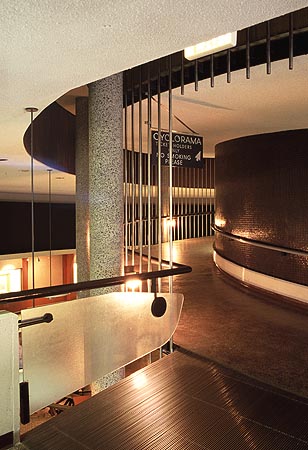 Gettysburg
today is viewed as hallowed ground, a nationalist shrine to both victor
and vanquished, Lincoln's triumphant "Union" and Jefferson
Davis's valiant "Lost Cause." But Neutra rightly interpreted
the battlefield legacy in a much larger sense, one that uniquely applied
Lincoln's vision to a contemporary international political context.
The U.S. Civil War Centennial Commission, created in 1957, set the tone
when they emphasized that the upcoming anniversary celebrations be devoted
to "keeping peace through international understanding." Neutra
incorporated this message wholeheartedly in the Cyclorama Building --one
of his last major public commissions. In his hands, the visitor center
became a place of "cultural interchange" rather than a mere
tourist trap. Crowds of up to 30,000 people could be accommodated outside
the building which opened up to reveal an elevated "Rostrum of
the Prophetic Voice." The visionary architect imagined that a procession
of "great statesmen of the Nations…may be even a 'Cold War'
enemy nation" such as India's Jawaharlal Nehru or China's Chou
En-Lai, would present stirring speeches promoting global unanimity at
the yearly anniversary of the Gettysburg Address. Where Lincoln spoke
poignantly of the shattered Union between northern and southern states,
Neutra dedicated his latter-day Lincoln Memorial to the cause of international
harmony in a world threatened with atomic annihilation and a nation
consumed with internal issues of civil rights. Gettysburg
today is viewed as hallowed ground, a nationalist shrine to both victor
and vanquished, Lincoln's triumphant "Union" and Jefferson
Davis's valiant "Lost Cause." But Neutra rightly interpreted
the battlefield legacy in a much larger sense, one that uniquely applied
Lincoln's vision to a contemporary international political context.
The U.S. Civil War Centennial Commission, created in 1957, set the tone
when they emphasized that the upcoming anniversary celebrations be devoted
to "keeping peace through international understanding." Neutra
incorporated this message wholeheartedly in the Cyclorama Building --one
of his last major public commissions. In his hands, the visitor center
became a place of "cultural interchange" rather than a mere
tourist trap. Crowds of up to 30,000 people could be accommodated outside
the building which opened up to reveal an elevated "Rostrum of
the Prophetic Voice." The visionary architect imagined that a procession
of "great statesmen of the Nations…may be even a 'Cold War'
enemy nation" such as India's Jawaharlal Nehru or China's Chou
En-Lai, would present stirring speeches promoting global unanimity at
the yearly anniversary of the Gettysburg Address. Where Lincoln spoke
poignantly of the shattered Union between northern and southern states,
Neutra dedicated his latter-day Lincoln Memorial to the cause of international
harmony in a world threatened with atomic annihilation and a nation
consumed with internal issues of civil rights.
Although Neutra's memorial concept resonated with America's international
ambitions at mid century, changing social and 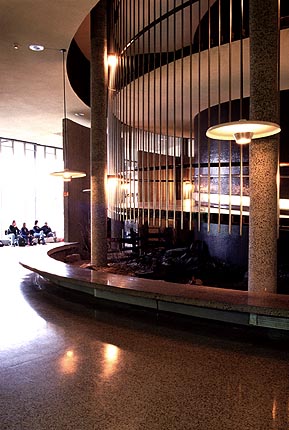 political
environments quickly rendered its utopian message ineffective. Today
the Park Service maintains that the building must be removed from the
battlefield. Yet Neutra's intentions for the structure and his humanistic
theories behind its development -for years suppressed and unexplored
-- are just beginning to be understood in the context of his period
and ours. political
environments quickly rendered its utopian message ineffective. Today
the Park Service maintains that the building must be removed from the
battlefield. Yet Neutra's intentions for the structure and his humanistic
theories behind its development -for years suppressed and unexplored
-- are just beginning to be understood in the context of his period
and ours.
In November, 2000,
the National Parks Advisory Board refused to grant National Historic
Landmark status to the Cyclorama Building, but approved the nominations
for three other Mission 66-era visitor centers with identical historic
contexts and statements of significance: Dinosaur,
Utah; Wright Brothers, North Carolina;
and Rocky Mountain, Colorado. Politics?
A renewed effort
to save the building is underway, led by the Recent Past Preservation
Network in cooperation with the Neutra Institute of Survival Through
Design, DOCOMOMO, and other allied organizations. This coalition of
preservationists is calling upon key public officials, including Pennsylvania
Gov. Edward Rendell, to "pardon" the building and provide
funds for its restoration. Only public support can save this building
now. Sign on here to save the Cyclorama!
[by Christine Madrid
French for the DOCOMOMO U.S.
newsletter; photographs ©Boris
Starosta]
| |
See
also select measured drawings of the building,
recently completed by the Historic American Buildings Survey
on our HABS Drawings page
featuring downloadable PDFs of each image. |
Other sites with
images:
Photo
Gallery of Images on the Richard and Dion Neutra Architecture site.
Other Documents:
Landscape
Preservation and Interpretation: Issues of Use, Historical Experience,
and Myth at Gettysburg National Military Park. Thesis by Nathan
Jefferson Riddle (Columbia University, 1998). Critical analysis of National
Park Service interpretive policies at Gettysburg NMP with special coverage
of Neutra's Cyclorama Building (ca. 1961) and its place on the battlefield
of Gettysburg.
| "The Gettysburg
park staff tendentiously approached writing the DOE with the intention
of portraying the building�s mechanical and maintenance problems
as inherent design flaws. The motive of the park service was to
portray the building as a lesser, pitiful example of Neutra�s work,
designed when he was in poor health and at the end of his partnership
with Robert Alexander. Based upon an anti-modern conceit of the
park Superintendent, the analysis is slanted and misleading. Latschar�s
intentions and the arguments used to support his proposals pose
dangers more general than to just Neutra�s building. The National
Park Service acts as a preservation mentor for the nation, and in
this regard, if the argument becomes accepted that the technical
failings of a structure render that work of negligible significance,
then the country would lose many cherished architectural icons."
Read more... |
|
 In
1996, the National Park Service officials announced their intention
to demolish Neutra and Alexander's 1961 modernist Cyclorama Building
at Gettysburg, Pennsylvania, a premiere first generation "visitor
center" and a stunning example of a master architect's late-life
aspirations. Despite its recent listing on the National Register of
Historic Places for its ""its exceptional historic and architectural
significance," the long-neglected building stands in the way of
National Park Service plans to "restore" the battlefield landscape
and move visitor facilities into a new interpretive center designed
in a "more appropriate" architectural style.
In
1996, the National Park Service officials announced their intention
to demolish Neutra and Alexander's 1961 modernist Cyclorama Building
at Gettysburg, Pennsylvania, a premiere first generation "visitor
center" and a stunning example of a master architect's late-life
aspirations. Despite its recent listing on the National Register of
Historic Places for its ""its exceptional historic and architectural
significance," the long-neglected building stands in the way of
National Park Service plans to "restore" the battlefield landscape
and move visitor facilities into a new interpretive center designed
in a "more appropriate" architectural style.  depicted
in the painting's brilliant scenography and a location deemed most convenient
for the multitudes expected to visit the building during the 100th anniversary
of the Civil War.
depicted
in the painting's brilliant scenography and a location deemed most convenient
for the multitudes expected to visit the building during the 100th anniversary
of the Civil War.  Gettysburg
today is viewed as hallowed ground, a nationalist shrine to both victor
and vanquished, Lincoln's triumphant "Union" and Jefferson
Davis's valiant "Lost Cause." But Neutra rightly interpreted
the battlefield legacy in a much larger sense, one that uniquely applied
Lincoln's vision to a contemporary international political context.
The U.S. Civil War Centennial Commission, created in 1957, set the tone
when they emphasized that the upcoming anniversary celebrations be devoted
to "keeping peace through international understanding." Neutra
incorporated this message wholeheartedly in the Cyclorama Building --one
of his last major public commissions. In his hands, the visitor center
became a place of "cultural interchange" rather than a mere
tourist trap. Crowds of up to 30,000 people could be accommodated outside
the building which opened up to reveal an elevated "Rostrum of
the Prophetic Voice." The visionary architect imagined that a procession
of "great statesmen of the Nations…may be even a 'Cold War'
enemy nation" such as India's Jawaharlal Nehru or China's Chou
En-Lai, would present stirring speeches promoting global unanimity at
the yearly anniversary of the Gettysburg Address. Where Lincoln spoke
poignantly of the shattered Union between northern and southern states,
Neutra dedicated his latter-day Lincoln Memorial to the cause of international
harmony in a world threatened with atomic annihilation and a nation
consumed with internal issues of civil rights.
Gettysburg
today is viewed as hallowed ground, a nationalist shrine to both victor
and vanquished, Lincoln's triumphant "Union" and Jefferson
Davis's valiant "Lost Cause." But Neutra rightly interpreted
the battlefield legacy in a much larger sense, one that uniquely applied
Lincoln's vision to a contemporary international political context.
The U.S. Civil War Centennial Commission, created in 1957, set the tone
when they emphasized that the upcoming anniversary celebrations be devoted
to "keeping peace through international understanding." Neutra
incorporated this message wholeheartedly in the Cyclorama Building --one
of his last major public commissions. In his hands, the visitor center
became a place of "cultural interchange" rather than a mere
tourist trap. Crowds of up to 30,000 people could be accommodated outside
the building which opened up to reveal an elevated "Rostrum of
the Prophetic Voice." The visionary architect imagined that a procession
of "great statesmen of the Nations…may be even a 'Cold War'
enemy nation" such as India's Jawaharlal Nehru or China's Chou
En-Lai, would present stirring speeches promoting global unanimity at
the yearly anniversary of the Gettysburg Address. Where Lincoln spoke
poignantly of the shattered Union between northern and southern states,
Neutra dedicated his latter-day Lincoln Memorial to the cause of international
harmony in a world threatened with atomic annihilation and a nation
consumed with internal issues of civil rights. political
environments quickly rendered its utopian message ineffective. Today
the Park Service maintains that the building must be removed from the
battlefield. Yet Neutra's intentions for the structure and his humanistic
theories behind its development -for years suppressed and unexplored
-- are just beginning to be understood in the context of his period
and ours.
political
environments quickly rendered its utopian message ineffective. Today
the Park Service maintains that the building must be removed from the
battlefield. Yet Neutra's intentions for the structure and his humanistic
theories behind its development -for years suppressed and unexplored
-- are just beginning to be understood in the context of his period
and ours. 